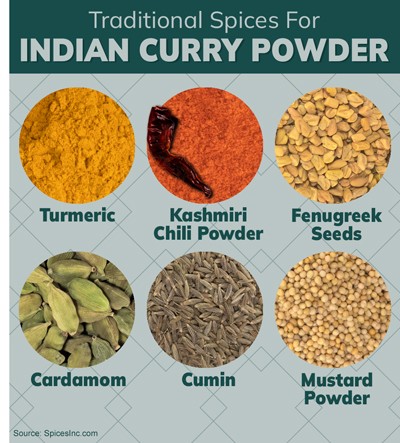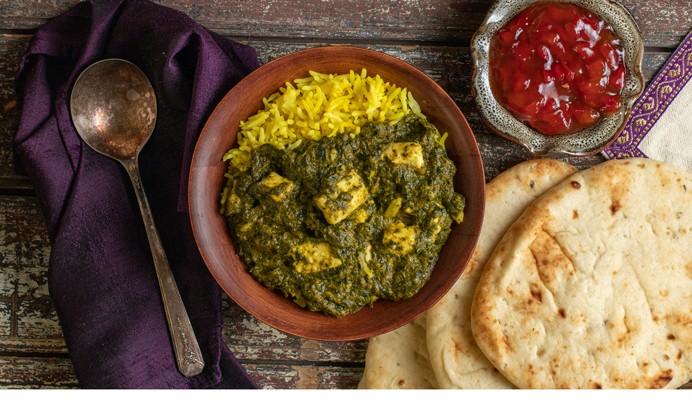Curry powder is a vibrant blend of spices, expertly crafted to bring the authentic taste of curry dishes to your kitchen, and at WHAT.EDU.VN, we understand that knowing what goes into your food is important. We’re here to help you unravel the mysteries of curry powder and explore its diverse applications, offering a comprehensive guide to this popular spice mix. Explore the different types, regional variations, and best uses, ensuring that you have all the information you need for culinary success. Seeking answers to your spice rack questions? Look no further.
1. Unveiling Curry Powder: The Quintessential Spice Blend
Curry powder is not a single spice, but a carefully balanced combination of multiple spices, designed to mimic the complex flavors found in traditional curry dishes. While often associated with Indian cuisine, curry powder is a Western invention, created to simplify the process of making curry for those unfamiliar with Indian cooking. The exact composition of curry powder can vary significantly, depending on the brand, region, and intended use. However, some spices are considered essential components of most curry powder blends.
1.1. Foundational Spices: The Building Blocks of Curry Powder
Several key spices form the base of most curry powder recipes, providing the fundamental flavors that define this versatile blend:
-
Turmeric: This vibrant yellow spice is perhaps the most recognizable ingredient in curry powder. Turmeric imparts a warm, earthy flavor and a characteristic golden hue to dishes. It is also known for its potent anti-inflammatory and antioxidant properties, thanks to the presence of curcumin.
Alt text: Close-up of vibrant turmeric powder, a key ingredient in curry blends, known for its earthy flavor and health benefits.
-
Coriander: Ground coriander seeds contribute a citrusy, slightly sweet, and warm flavor to curry powder. It adds a subtle complexity and helps to balance the other, more intense spices.
-
Cumin: Cumin brings a warm, earthy, and slightly bitter flavor to the mix. Its strong aroma and distinctive taste are essential for creating authentic curry flavor.
-
Fenugreek: Fenugreek seeds offer a unique flavor profile, with notes of maple syrup and a slightly bitter aftertaste. It adds depth and complexity to the overall blend.
1.2. Enhancing Flavors: Secondary Spices in the Mix
In addition to the foundational spices, many curry powder recipes incorporate a variety of other spices to enhance the flavor and aroma:
- Ginger: Ground ginger adds a warm, spicy, and slightly sweet note to curry powder.
- Garlic: Garlic powder provides a pungent, savory flavor that complements the other spices.
- Red Pepper: Chili powder or cayenne pepper contributes heat to the blend, ranging from mild to intensely spicy, depending on the quantity used.
- Cinnamon: Cinnamon adds a warm, sweet, and slightly spicy note, providing a subtle touch of sweetness and warmth.
- Cardamom: Cardamom offers a complex flavor profile with notes of citrus, mint, and spice, adding a touch of elegance to the curry powder.
- Cloves: Ground cloves provide a strong, warm, and aromatic flavor that adds depth and complexity to the blend.
- Mustard Seed: Mustard seeds contribute a pungent, slightly bitter flavor that enhances the savory notes in the curry powder.
- Black Pepper: Black pepper adds a touch of heat and enhances the overall flavor profile of the blend.
1.3. Regional Variations: A World of Curry Powders
The composition of curry powder can vary significantly depending on the region and culinary traditions. Each variation offers a unique flavor profile, catering to local preferences and culinary styles:
- Indian Curry Powder: Indian curry powders often include a wider range of spices, such as mace, nutmeg, and bay leaf. They tend to be more complex and aromatic than other variations.
- Madras Curry Powder: This type of curry powder is known for its vibrant red color and relatively high heat level, thanks to the inclusion of red chilies.
- Sri Lankan Curry Powder: Sri Lankan curry powders often feature roasted spices, which impart a deeper, more intense flavor. They may also include ingredients like pandan leaves and lemongrass.
- Thai Curry Paste: While not technically a powder, Thai curry pastes share a similar goal of flavoring curry dishes. They typically include fresh ingredients like chilies, galangal, lemongrass, and kaffir lime leaves, along with spices like coriander, cumin, and turmeric.
1.4. The Art of Blending: Creating Your Own Curry Powder
Making your own curry powder allows you to customize the flavor profile to your exact preferences. You can adjust the heat level, emphasize certain spices, and create a unique blend that perfectly complements your favorite dishes.
Experiment with different ratios of spices to create your own signature curry powder. Store your homemade blend in an airtight container in a cool, dark place to preserve its flavor and aroma.
2. Decoding the Flavor Profile: What Does Curry Powder Taste Like?
The taste of curry powder is a complex interplay of sweet, savory, and spicy notes. The precise flavor profile depends on the specific spices used in the blend and their relative proportions. However, some general characteristics can be attributed to most curry powders:
2.1. Earthy Undertones: The Foundation of Curry Flavor
Turmeric and cumin provide the earthy undertones that form the foundation of curry powder’s flavor profile. These spices lend a grounding, slightly musky flavor that balances the other, more vibrant spices.
2.2. Warm Spices: Adding Depth and Complexity
Ginger, cinnamon, and cloves contribute warm, aromatic notes that add depth and complexity to the curry powder. These spices provide a comforting, subtly sweet flavor that complements the savory elements.
2.3. Bright Top Notes: Zesty and Refreshing
Coriander and cardamom offer bright top notes that add a touch of zest and freshness to the curry powder. These spices lend a citrusy, slightly sweet flavor that balances the heavier, earthy notes.
2.4. Spicy Kick: A Range of Heat Levels
The level of spiciness in curry powder can vary widely, depending on the amount of chili powder or cayenne pepper used. Some blends are mild and subtly warming, while others pack a significant punch.
2.5. Umami Essence: A Savory Depth
Ingredients like fenugreek and mustard seeds contribute to the umami essence of curry powder, providing a savory depth that enhances the overall flavor. This adds a layer of complexity that makes the curry powder more satisfying.
3. Culinary Applications: How to Use Curry Powder in Your Cooking
Curry powder is a versatile spice blend that can be used in a wide range of dishes, from traditional curries to innovative fusion creations. Its complex flavor profile adds depth, warmth, and a touch of exotic flair to any recipe.
3.1. Classic Curries: Recreating Authentic Flavors
The most obvious use for curry powder is in making curries. It can be used to season vegetables, meats, and legumes in a variety of curry preparations. Experiment with different types of curry powder to create unique flavor profiles.
Alt text: A vibrant bowl of homemade curry, showcasing the rich colors and textures of the dish, flavored with a complex blend of curry spices.
3.2. Roasting Vegetables: Enhancing Natural Sweetness
Sprinkling curry powder over vegetables before roasting enhances their natural sweetness and adds a warm, savory flavor. It works particularly well with root vegetables like carrots, potatoes, and sweet potatoes.
3.3. Flavoring Soups and Stews: Adding Depth and Warmth
Adding a spoonful of curry powder to soups and stews can transform a simple dish into a flavorful and aromatic experience. It pairs well with lentil soup, chicken stew, and vegetable broth.
3.4. Seasoning Meats and Poultry: Creating Savory Crusts
Curry powder can be used as a dry rub for meats and poultry, creating a flavorful crust during grilling or roasting. It adds a warm, spicy, and aromatic flavor that complements the natural taste of the meat.
3.5. Enhancing Rice and Grains: Adding Exotic Notes
Stirring a teaspoon of curry powder into rice or other grains while cooking adds an exotic flavor that elevates the dish. It pairs well with basmati rice, quinoa, and couscous.
3.6. Spicing Up Snacks: Adding a Unique Twist
Curry powder can be used to add a unique twist to snacks like popcorn, roasted nuts, and potato chips. It provides a warm, savory, and slightly spicy flavor that is both addictive and satisfying.
4. Health Benefits: Unlocking the Power of Curry Powder
In addition to its culinary versatility, curry powder also offers a range of potential health benefits, thanks to the presence of various spices known for their medicinal properties:
4.1. Anti-Inflammatory Properties: Reducing Inflammation
Turmeric, a key ingredient in curry powder, contains curcumin, a potent anti-inflammatory compound. Curcumin has been shown to reduce inflammation throughout the body, potentially alleviating symptoms of arthritis, inflammatory bowel disease, and other inflammatory conditions.
4.2. Antioxidant Effects: Protecting Against Free Radicals
Many spices in curry powder, such as turmeric, ginger, and cloves, are rich in antioxidants. Antioxidants help protect the body against damage from free radicals, which can contribute to aging, chronic diseases, and cancer.
4.3. Digestive Benefits: Aiding Digestion
Ginger, cumin, and coriander, commonly found in curry powder, have been shown to aid digestion. They can help reduce bloating, gas, and indigestion.
4.4. Heart Health: Promoting Cardiovascular Wellness
Some studies suggest that the spices in curry powder may help improve heart health. Curcumin, in particular, has been shown to lower cholesterol levels and improve blood vessel function.
4.5. Brain Health: Supporting Cognitive Function
Curcumin has also been linked to improved brain health. It may help protect against age-related cognitive decline and improve memory and mood.
5. Storage Tips: Preserving the Flavor of Your Curry Powder
To ensure that your curry powder retains its flavor and aroma, proper storage is essential. Follow these tips to keep your curry powder fresh for longer:
5.1. Airtight Containers: Preventing Moisture and Air Exposure
Store curry powder in an airtight container to prevent moisture and air from degrading its flavor. Glass or metal containers with tight-fitting lids are ideal.
5.2. Cool, Dark Place: Avoiding Heat and Light
Keep curry powder in a cool, dark place away from direct sunlight and heat. Exposure to heat and light can cause the spices to lose their potency and flavor.
5.3. Avoid Humidity: Preventing Clumping
Avoid storing curry powder in humid environments, such as near the stove or sink. Humidity can cause the spices to clump together and lose their flavor.
5.4. Shelf Life: Knowing When to Replace
Curry powder typically has a shelf life of about 1-2 years. After that, the spices may start to lose their flavor and aroma. To ensure the best flavor, replace your curry powder every year or two.
6. Addressing Common Concerns: Safety and Allergies
While curry powder is generally safe for consumption, some individuals may have concerns about allergies or potential side effects.
6.1. Allergies: Identifying Potential Triggers
Some individuals may be allergic to specific spices found in curry powder, such as mustard seed or fenugreek. If you have known spice allergies, carefully check the ingredient list before using curry powder.
6.2. Potential Side Effects: Moderation is Key
Consuming large amounts of curry powder may cause digestive upset in some individuals. Moderation is key to avoiding any potential side effects.
6.3. Drug Interactions: Consulting Your Doctor
Curcumin, found in turmeric, may interact with certain medications, such as blood thinners. If you are taking any medications, consult your doctor before consuming large amounts of curry powder.
6.4. Quality Concerns: Choosing Reputable Brands
To ensure the quality and safety of your curry powder, choose reputable brands that use high-quality ingredients and follow strict manufacturing standards.
7. Frequently Asked Questions (FAQs) About Curry Powder
| Question | Answer |
|---|---|
| What is the main ingredient in curry powder? | The main ingredient is typically turmeric, which gives curry powder its characteristic yellow color and earthy flavor. |
| Is curry powder the same as garam masala? | No, curry powder and garam masala are different spice blends. Garam masala is a traditional Indian spice blend, while curry powder is a Western invention that attempts to replicate Indian flavors. |
| Is curry powder spicy? | The spiciness of curry powder varies depending on the amount of chili powder or cayenne pepper used. Some blends are mild, while others are quite spicy. |
| Can I make my own curry powder? | Yes, you can easily make your own curry powder by blending various spices to your liking. This allows you to customize the flavor profile to your preferences. |
| How should I store curry powder? | Store curry powder in an airtight container in a cool, dark, and dry place to preserve its flavor and aroma. |
| What are the health benefits of curry powder? | Curry powder contains various spices with potential health benefits, such as anti-inflammatory and antioxidant properties. However, moderation is key. |
| Can I use curry powder in non-Indian dishes? | Yes, curry powder is a versatile spice blend that can be used in a variety of dishes, including soups, stews, roasted vegetables, and even snacks. |
| Is curry powder vegan? | Yes, curry powder is typically vegan, as it consists solely of plant-based spices. |
| Where can I buy curry powder? | Curry powder is widely available in most grocery stores and spice shops. You can also purchase it online from various retailers. |
| How long does curry powder last? | Curry powder typically has a shelf life of about 1-2 years. After that, the spices may start to lose their flavor and aroma. |


8. Navigating the Spice Rack: A Conclusion on Curry Powder
Curry powder is a fascinating and versatile spice blend that can add a world of flavor to your cooking. Understanding its composition, flavor profile, and culinary applications allows you to use it with confidence and creativity in your kitchen. Whether you’re a seasoned chef or a novice cook, curry powder is a valuable addition to your spice collection.
8.1. Embracing Culinary Exploration
Don’t be afraid to experiment with different types of curry powder and explore the many ways it can enhance your favorite dishes. With a little creativity, you can unlock a world of flavor possibilities.
8.2. Seeking Further Guidance
Still have questions about curry powder or other culinary topics? At WHAT.EDU.VN, we’re dedicated to providing you with the answers you need. Our platform offers a free and easy way to ask any question and receive expert advice from our community of knowledgeable users.
8.3. Your Invitation to Ask
Do you have burning questions about the culinary arts, spice blends, or anything else? Don’t hesitate to reach out to us at WHAT.EDU.VN. We’re here to help you navigate the world of knowledge and unlock your full potential.
Unlock the answers to your questions today at WHAT.EDU.VN!
Address: 888 Question City Plaza, Seattle, WA 98101, United States
WhatsApp: +1 (206) 555-7890
Website: what.edu.vn
We look forward to hearing from you and helping you on your quest for knowledge.
